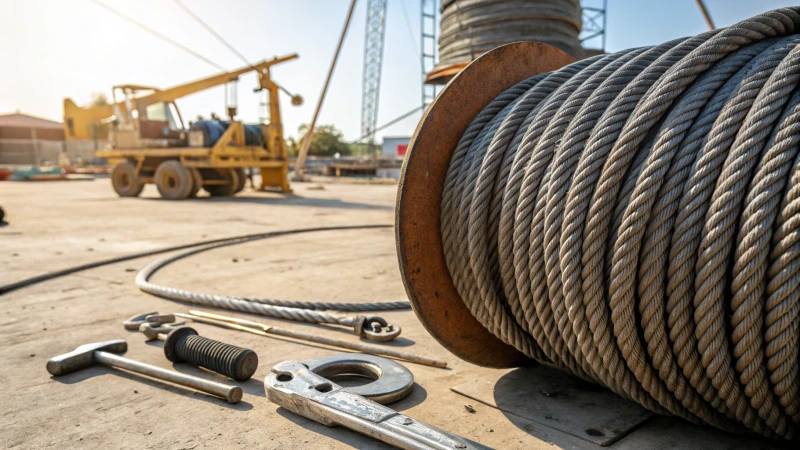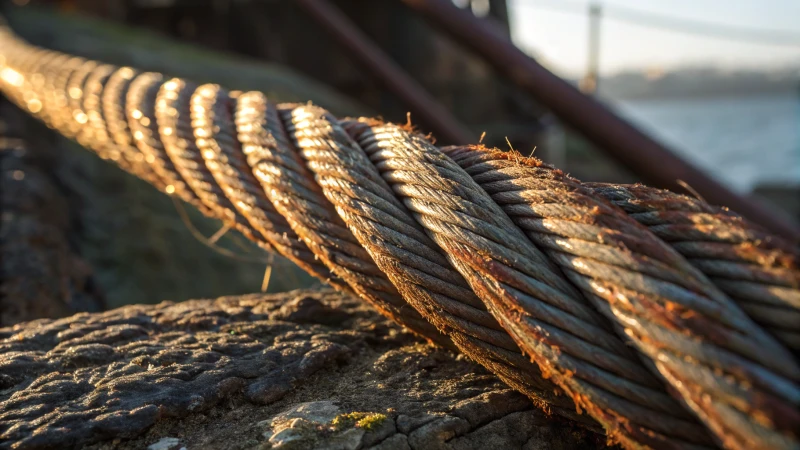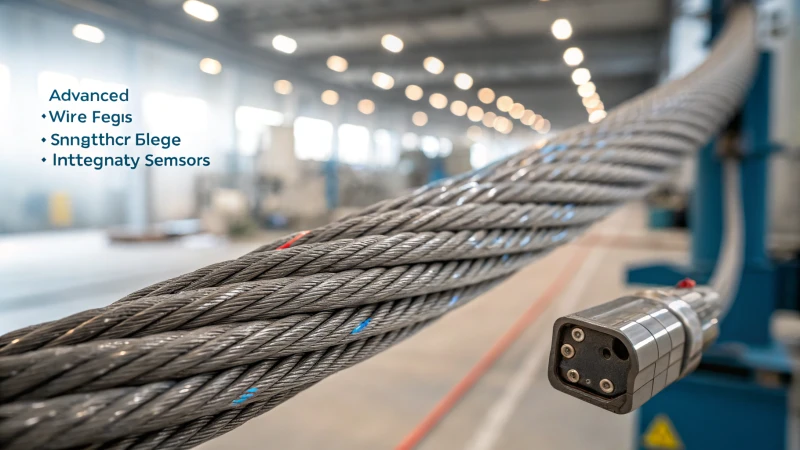
Ever found yourself tangled up in decisions about steel wire ropes for your construction projects?
To choose the best heavy-duty steel wire rope for construction projects, I consider factors like tensile strength, flexibility, corrosion resistance, and load-bearing capacity. Evaluating the project's unique needs and consulting with reliable suppliers ensures we meet safety standards and achieve top performance.
I remember the first time I had to select a steel wire rope. The choices felt overwhelming—like being in a candy store with a strict budget. I quickly learned that understanding our project's specific requirements made all the difference. By focusing on essential criteria like strength and flexibility, and by having candid conversations with suppliers who understood our needs, I managed to navigate the complexities. Let's delve deeper into this topic together, exploring advanced materials and customization options that can further tailor our choices to fit even the most demanding project specifications.
Tensile strength is the only factor for choosing wire ropes.False
Other factors like flexibility, corrosion resistance, and load capacity are crucial.
Consulting with suppliers ensures compliance with safety standards.True
Suppliers can provide expert advice on meeting industry safety requirements.
What Factors Should You Consider When Selecting Steel Wire Ropes?
Steel wire ropes might not sound thrilling, but choosing the right one is like picking the perfect tool for the job—it makes all the difference!
When selecting steel wire ropes, consider factors such as load capacity, tensile strength, flexibility, corrosion resistance, and environmental conditions. These elements ensure the rope’s durability and performance for your specific needs.

Load Capacity and Tensile Strength
I remember the first time I had to select a steel wire rope. I was both excited and nervous because getting it wrong could mean serious safety issues. Load capacity quickly became my first checkpoint. It's the maximum weight the rope can safely handle without snapping. Alongside that, I learned about tensile strength1, which measures how much stress the rope can take before it breaks under tension.
| Factor | Description |
|---|---|
| Load Capacity | Maximum weight supported safely |
| Tensile Strength | Stress endurance before breaking |
This understanding was crucial to ensure the rope could handle the intended loads safely without any room for error.
Flexibility and Construction
Flexibility is another factor that can’t be overlooked, especially if your work involves frequent bending of the ropes. I once worked on a project where we needed ropes that could twist and turn without getting fatigued. The construction of the rope, like how many strands and wires are involved, greatly impacts this. A higher number of smaller wires per strand often gives more flexibility, making it easier to maneuver around tight spots.
Construction Types2 such as 6x19 or 6x36 each offer different flexibility levels, suited to various operational needs.
Corrosion Resistance
Dealing with corrosion can be a real headache, especially if you’re working in harsh environments. I recall a time when we opted for galvanized ropes thinking they’d suffice, only to find out stainless steel would have been better for resisting corrosion over time.
| Type | Corrosion Resistance |
|---|---|
| Galvanized | Basic protection |
| Stainless Steel | Superior resistance |
Corrosion protection3 becomes especially important in marine settings where saltwater exposure is a constant threat.
Environmental Conditions
Never underestimate the environment’s impact on your rope’s performance. I learned this lesson during a project offshore where the saltwater and fluctuating temperatures were relentless. It's crucial to consider temperature, humidity, and chemical exposure. For example, in high-heat environments like industrial settings, choosing temperature-resistant ropes is key.
Safety Standards and Compliance
Safety is non-negotiable. Ensuring compliance with industry standards like those set by OSHA or other relevant authorities isn’t just about ticking boxes—it’s about protecting everyone involved. When I look for ropes now, I always verify their safety certifications to ensure they meet essential safety criteria and are fit for demanding environments.
Safety certifications4 provide peace of mind that you're using equipment designed to keep everyone safe.
Steel wire ropes with more wires per strand are less flexible.False
More wires per strand increase flexibility, not decrease it.
Stainless steel ropes offer superior corrosion resistance.True
Stainless steel provides better protection against corrosion than galvanized steel.
Why is corrosion resistance vital for wire rope performance?
Imagine a world where your wire ropes stay as strong as the day you bought them, regardless of the environment.
Corrosion resistance in wire ropes is crucial for maintaining their strength and reliability, especially in harsh environments. It prevents rust and wear, ensuring the ropes perform optimally and safely across industries like construction, marine, and industrial settings.

The Role of Corrosion Resistance in Wire Ropes
I remember the first time I saw the effects of corrosion on a wire rope during a project by the coast. It was shocking how quickly the saltwater environment could eat away at the metal. We had chosen the wrong material, and it cost us dearly in both time and resources. Now, I always ensure that corrosion resistance is a top priority. In these environments, using galvanized steel5 or stainless steel ropes becomes non-negotiable, as they withstand the elements far better, maintaining their strength and functionality over time.
Materials and Coatings That Enhance Corrosion Resistance
It's amazing how much of a difference choosing the right materials can make. I once switched from regular steel to stainless steel for a marine project, and the ropes lasted twice as long! Stainless steel naturally resists rust and corrosion, but sometimes a little extra protection is needed. Coatings like zinc galvanization add another layer of defense against moisture. For even more assurance in chemically harsh settings, applying PVC or nylon coatings6 creates a robust barrier, keeping the core safe from corrosive agents.
| Material | Properties | Ideal Use |
|---|---|---|
| Galvanized Steel | Zinc coating for rust protection | Marine, Construction |
| Stainless Steel | High resistance to corrosion | Marine, Industrial |
| PVC Coated Ropes | Physical barrier against moisture | Chemical Plants, Outdoor Applications |
Environmental Factors Influencing Corrosion
I’ve learned that location can make all the difference. Working in coastal areas taught me how salt air speeds up rusting, compelling me to choose materials that could brave such environments. In industrial settings with chemical exposure, specialized coatings are essential to combat these aggressive agents effectively.
Preventative Measures and Maintenance Strategies
Through trial and error, I discovered that routine maintenance is invaluable. By setting a regular schedule for inspections and applying protective lubricants, I've managed to extend the life of wire ropes significantly. Early detection methods like non-destructive testing7 have also been game-changers, allowing me to catch internal corrosion before it leads to failures.
In conclusion, understanding how corrosion resistance affects wire rope performance has transformed my approach to selecting materials and coatings, ensuring they meet specific operational needs while upholding safety and efficiency.
Stainless steel wire ropes resist corrosion naturally.True
Stainless steel inherently resists rust and corrosion due to its composition.
Galvanized steel ropes are unsuitable for marine use.False
Galvanized steel is ideal for marine use due to its zinc coating.
What are the latest advances in wire rope technology?
Ever thought wire ropes were just, well, ropes? Think again! The world of wire rope technology is buzzing with innovations that could change the game in industries like construction, mining, and more.
The latest advances in wire rope technology involve high-performance materials such as synthetic fibers, real-time monitoring through smart sensors, and innovative coatings that improve durability and resistance to corrosion.

High-Performance Materials
Let's talk about the time I had to lift a massive steel beam during a construction project. It was nerve-wracking! But thanks to the new generation of wire ropes made with synthetic fibers8, things went smoothly. These fibers offer an incredible strength-to-weight ratio, which means they’re light enough to handle easily yet strong enough to take on heavy-duty tasks. Think about how efficient it is when every pound counts—like reducing machinery wear and tear.
Smart Monitoring Systems
I once faced a close call when a wire rope started fraying without anyone noticing until it was nearly too late. That's why I'm thrilled about smart sensors9 now integrated into wire ropes. These sensors are like having a watchful eye 24/7, detecting stress or corrosion in real-time. This technology isn’t just about safety; it’s about peace of mind, knowing that any potential issue can be tackled before it escalates.
Innovative Coatings and Treatments
Remember the time we had to deal with rusted ropes on a rainy site? Enter polymer coatings10. They’re like a superhero cape for wire ropes, providing an extra layer of protection against harsh environmental factors. These coatings help ensure that the ropes perform optimally, even when Mother Nature isn’t cooperating. For sectors like mining and construction, these advancements are game-changers.
Customization for Specific Applications
Customization is like tailoring a suit—it’s all about the perfect fit. In our projects, adjusting wire ropes to meet specific needs—be it diameter, flexibility, or tensile strength—has allowed us to optimize operations significantly. This bespoke approach means we’re not just using any rope; we’re using the right rope for the job11.
Comparative Table: Traditional vs. Advanced Wire Ropes
| Feature | Traditional Wire Ropes | Advanced Wire Ropes |
|---|---|---|
| Material | Steel | Synthetic Fibers |
| Monitoring | Visual Inspection | Smart Sensors |
| Coating | Basic Galvanization | Polymer Coating |
| Weight | Heavy | Lightweight |
| Customization Options | Limited | Extensive |
These innovations aren’t just enhancing performance—they’re cutting costs and boosting safety across industries. As we continue to push technological boundaries, the potential for further breakthroughs in wire rope technology is both vast and exciting.
Synthetic fibers improve wire rope strength-to-weight ratio.True
Synthetic fibers provide excellent strength while being lightweight.
Smart sensors increase wire rope maintenance costs.False
Smart sensors reduce costs by enabling preventive maintenance.
Why Customize Your Wire Rope Selection?
Have you ever wondered how tweaking the components of a wire rope can boost its performance?
Customizing wire ropes means selecting the right materials, coatings, and configurations to suit specific needs. This process not only improves durability and safety but also enhances performance, making customized ropes perfect for specialized tasks in demanding industries like construction and mining.

Understanding Wire Rope Customization
I've always been fascinated by how the little details can make a big difference, especially when it comes to something as crucial as wire ropes in construction or mining. Customization here involves tailoring the rope's components—whether it's the material type12, coating, or configuration—to fit particular tasks. For instance, I remember a project where choosing stainless steel ropes was a game-changer because of their corrosion resistance, especially in a marine setting.
Benefits of Customization
-
Enhanced Durability: Think about those times when a project demanded more than just regular performance. Selecting materials like galvanized or stainless steel ensures the rope can endure harsh environments, minimizing wear and tear.
Material Type Benefits Stainless Steel High corrosion resistance Galvanized Excellent durability -
Improved Safety: There was this one time in my career when we needed ropes that wouldn't fail under heavy loads. Custom ropes designed to meet specific safety standards provided peace of mind and kept everyone safe.
-
Optimized Performance: I recall needing a specific strand pattern13 for better flexibility in cranes during a complex build. Tailoring the ropes to our exact needs enhanced their performance significantly.
Customization Options
- Material Selection: Depending on environmental conditions and load requirements, choosing the right steel type can make all the difference.
- Coatings: Adding PVC or nylon coatings provides that extra layer of protection.
- Configurations: Opting for different strand patterns14 can improve either flexibility or strength.
Customization is like crafting a bespoke suit—it fits perfectly and functions flawlessly. In mining, for example, ropes with enhanced abrasion resistance are essential to handle the rough conditions underground. Similarly, in construction, selecting ropes with high tensile strength ensures they can safely manage heavy loads.
By tailoring wire ropes to align with specific industry needs, not only do we optimize efficiency and longevity, but we also pave the way for innovative solutions that could lead to cost savings and better project outcomes. With ongoing advancements in material science and technology, I'm excited about the expanding possibilities for customization.
Stainless steel ropes are ideal for marine environments.True
Stainless steel offers high corrosion resistance, crucial in marine settings.
Galvanized ropes have poor durability in harsh conditions.False
Galvanized ropes are known for excellent durability in harsh conditions.
Conclusion
Choosing the best heavy-duty steel wire rope for construction requires evaluating tensile strength, flexibility, corrosion resistance, and load capacity to ensure safety and performance in demanding environments.
-
Learn how tensile strength affects a rope's performance and application suitability. ↩
-
Explore different construction types to find the most flexible option for your needs. ↩
-
Find top corrosion-resistant ropes ideal for marine applications. ↩
-
Understand important safety certifications for ensuring reliable use. ↩
-
Galvanized steel offers excellent protection against rust and corrosion, making it suitable for demanding environments like marine applications. ↩
-
PVC or nylon coatings enhance wire rope durability by providing a barrier against environmental damage such as moisture and chemicals. ↩
-
Non-destructive testing helps detect internal flaws in wire ropes without causing damage, ensuring safety and reliability. ↩
-
Explore how synthetic materials enhance wire rope performance with their strength-to-weight ratio benefits. ↩
-
Learn about smart sensors that provide real-time monitoring for better maintenance of wire ropes. ↩
-
Understand how polymer coatings protect wire ropes from environmental damage. ↩
-
Discover the benefits of customizing wire ropes for specific industrial needs. ↩
-
Understanding material options helps you select the right wire rope for your specific needs. ↩
-
Discovering strand patterns aids in choosing a rope with the desired flexibility for your projects. ↩
-
Exploring configurations offers insights into optimizing rope performance through customization. ↩

